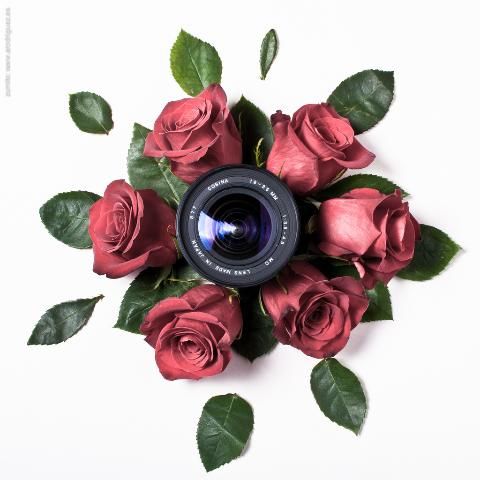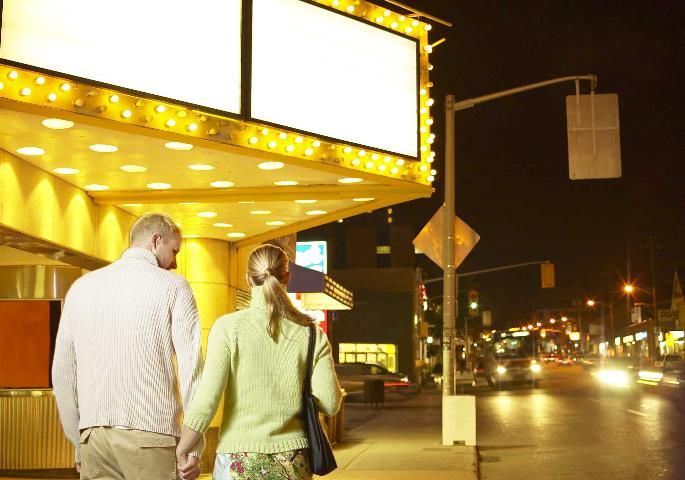The famous author, scholar, and inventor Albert Einstein offered this perspective on dating and romantic relationships: "Any man who can drive safely while kissing a pretty girl is simply not giving the kiss the attention it deserves." It is important to "pay close attention" to what is happening in dating relationships because they are the building blocks for healthy marriage relationships. Using different perspectives, or lenses, to help us understand and assess the health of our romantic relationships is one tool we can use to give them "the attention they deserve." These lenses can be used to help us see why healthy dating can lead to healthy marriages or why unhealthy dating can lead to unhealthy marriages and divorce.

Credit: Romance by Alberto Rodriguez (CC BY-NC-SA 2.0).
Helpful Information
Four of the major lenses we can use to see if our dating and marriage relationships are healthy or unhealthy are discussed below.
It is often said that fiction mirrors "real life." As we look at the four lenses through the eyes of Lily and Alex, characters from the play "Lily's Life: Change of Plans" by Gail Ready, we can gain a clearer perspective of how to view our relationships through those lenses. Lily, a young wife, has just discovered that she is pregnant. Her husband Alex has created a schedule of goals and plans for his life, none of which include a baby in the near future. Afraid to tell Alex, Lily shares the news of her pregnancy with the other significant people in her life. Alex learns the news from an overheard conversation. Hurt and confused, he leaves home to stay with his father for a few days. Lily's grandmother orchestrates a meeting between the two.
Attachment Lens
The Attachment Lens is the primary framework used to understand the evolution of healthy and unhealthy relationships from birth through adulthood. Secure attachment occurs when we are able to depend on a primary caregiver or partner to be both available and responsive in interactions. When this occurs consistently, trust and intimacy are developed. When we cannot expect the primary attachment figures in our lives to be dependable, available, or responsive, we may become insecure in our relationships and even avoidant of others. This insecurity and avoidance can make it more difficult to develop trust and intimacy, thus influencing how we view our relationships and ourselves. Extreme "neediness" or an inability to communicate felt needs, for example, are common consequences of insecure and avoidant attachment relationships. These relationship patterns and expectations are developed in childhood and are reinforced and perpetuated through adolescence and adulthood unless they are changed through experience and other reinforcement.1 As a result, we all enter romantic relationships prior to marriage with varying abilities to develop and maintain trust and intimacy, and these abilities, unless altered by new knowledge, skills, and experiences, will likely remain relatively consistent throughout our adult romantic relationships.2
Growing up with a free spirited mother more concerned with universal harmony than with order and discipline, our character Lily had a parent who, while available, was not always completely dependable. The Attachment Lens helps us understand Lily's trust issues with Alex. Her inability to tell Alex about the pregnancy and his reaction are explored in the following excerpt:
ALEX. I'm your husband. You should be able to tell me anything.
LILY. Yes, yes, I should be able to tell you anything. That's what I want, Alex. That's what I need. But I can't do that.
ALEX. Why can't you, Lily?
LILY. Because I'm afraid! I've been afraid every day since I found out about the baby.
ALEX. Afraid of me?
LILY. Afraid of disappointing you.
ALEX. What?
LILY. You know exactly what you want to do with your life. You have everything all planned out. I'm not that way, Alex. I know who you want me to be, but I'm just not. I ... I don't know if I fit with you.
ALEX. Lily, you never disappoint me. You do fit. Without you, nothing would fit. I didn't marry you thinking I could change who you are. I like who you are. I like that we're so different. I thought ... we balanced each other.
Lifespan Development Lens
The Lifespan Development Lens suggests what "normal" human and relationship development might look like and seeks to explain the interaction of genetics, environment, and personal choices on how romantic relationships are both developed and maintained into adulthood. Potential consequences of these interactions may enhance or inhibit current and future romantic and marital possibilities and outcomes (e.g., abstinence, teen pregnancy, abortion, adoption, STDs).3
In "Lily's Life," Lily's mother Sarah is seeking a romantic relationship of her own. In the following excerpt, Sarah talks with her own mother, Willow, about Sarah's attraction to Alex's father, James. The women explore through the Lifespan Development Lens how James', environment, choices, and genetics have made him the man that he is.
WILLOW. So, you think you'll give the guy a chance?
SARAH. I don't know. He's nice enough, but he's so... so... well, you know.
WILLOW. I do know.
SARAH. You like him, don't you?
WILLOW. You know, the older I get, the more I believe that we're all products of our environment. James, like all of us, became what he needed to be to make his life work. It couldn't have been easy raising a child on his own. Really being there for his child, while he worked, kept the bills paid.
SARAH. Yeah, he did a good job. Raised a good son. Alex obviously admires his father. So, you do like him.
WILLOW. Hmmm, let me see now. He's bright, goal oriented, likes a good plan, and he's tall. What's not to like?
Social Exchange Lens

Credit: Hemera Technologies/AbleStock.com/Thinkstock.com
The Social Exchange Lens helps to explain why we may choose to leave or maintain romantic relationships. The goal of developing and maintaining relationships from a social exchange lens is to maximize benefits and to minimize costs. When the costs of being in a relationship begin to outweigh the benefits, we are more likely to leave or to dissolve a relationship unless high levels of commitment are present.4
When Alex returns home from his father's house, he and Lily begin an awkward conversation, trying to determine where they each stand in terms of costs versus benefits in their relationship. In order to resume a healthy relationship, they must work through their hurt and find the greater benefit in being together.
ALEX. So, you didn't ask me here to apologize?
LILY. Apologize? For what? For being pregnant?
ALEX. You know that's not fair.
LILY. Fair? You wanna talk about what's not fair? Running away is not fair.
ALEX. I did not run away. You knew where I was. You knew I was coming home. I have feelings too, Lily!
LILY. You have feelings? Well, ya sure had me fooled.
ALEX. What does that even mean?
LILY. It means, Alex, that I never know what you're feeling because you never show me. You don't talk to me!
Human Ecological Lens
The Human Ecological Lens posits that we are all greatly influenced by our surrounding circumstances and that individual needs motivate a wide range of choices regarding how we act, react, and interact in our romantic relationships.5
In the final excerpt from "Lily's Life," Lily and Alex work through their feelings and look at their own needs, based on their circumstances. Viewing their situation through the Human Ecological Lens, we begin to better understand the choices they have made and their reactions to each other.
ALEX. I got confused, Lily. I felt like I had no control over my own life. Like I had no say in the matter.
LILY. I know exactly what you mean. Alex, you know I wasn't trying to get pregnant, right?
ALEX. Yes, of course I know that. You don't think I'm upset about the baby.
LILY. You're not?
ALEX. No! I admit I'm a little afraid myself. No, no I'm terrified. We're gonna have a lot of changes to deal with. Everything will be different. We have so much to think about. A lot of plans to make—
LILY. But we're partners. We can do this together. Right? People do it all the time.
ALEX. Right. All the time. I don't want to be without you, Lily.
LILY. I don't want to be without you, Alex.
Things You Can Use
As you think about these lenses that we can use to evaluate our relationships, take a minute to rate your own current romantic relationship by using the unofficial assessment and scale presented in Table 1.
Endnotes
1 Cassidy, J., & Shaver, P. R. (1999). Part IV: Attachment in adolescence and adulthood. In J. Cassidy and P. R. Shaver (Eds.), Handbook of Attachment. New York: Guilford.
2 Karney, B. R., Beckett, M. K., Collins, R. L. & Shaw, R. (2007). Adolescent romantic relationships as precursors to healthy adult marriage – executive summary. Santa Monica, CA: Rand Corporation and The Department of Health and Human Services. Online: http://www.rand.org/content/dam/rand/pubs/technical_reports/2007/RAND_TR488.pdf [15 November 2012].
3 Ibid; Berger, K. (2005). The developing person through the life span. New York, NY: Worth.
4 White, J. M., & Klein, D. M. (2002). Family theories (2nd Ed.). Thousand Oaks, CA: Sage; See Johnson, M. P., Caughlin, J. P., & Huston, T. L. (1999). The tripartite nature of marital commitment: Personal, moral, and structural reasons to stay married. Journal of Marriage and the Family, 61(1), 160–177.
5 Bubolz, M. M., & Sontag, S. M. (1993). Human ecology theory. In P. G. Boss, W. J. Doherty, R. LaRossa, W. R. Schumm, & S. K. Steinmetz (Eds.), Sourcebook of family theories and methods: A contextual approach. New York: Plenum.
Harris, V. W. (2012). Eight Needs of Every Partner, Parent, and Child. Gainesville: University of Florida Institute of Food and Agricultural Sciences. FCS2313. https://edis.ifas.ufl.edu/fy1275